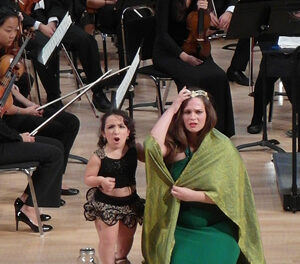Aside from diagnosing the reason for George Gershwin’s lifelong bachelorhood, music director Christopher Warren-Green had little to say about “Fascinatin’ Rhythm,” Charlotte Symphony’s all-Gershwin concert at Belk Theater – except that he’d been wanting to perform such a program for a long time. So the evening marked a bevy of firsts. In Warren-Green’s first season as Charlotte Symphony’s maestro, this was his first time at the helm of an American orchestra leading an all-American program. Indeed, it was the first time in quite awhile – perhaps the first time ever – that a Symphony maestro was at the podium for a winter Pops program. For many in the orchestra, it was likely the first time they were playing for a music director with Warren-Green’s zest for American music.
The mutual admirations and enthusiasms produced “S’Wonderful” results, beginning with a richly percussive excursion south of the border in “Cuban Overture.” Bongos and a guiro were the most recognizably Latin-flavored instruments wielded by a battery of five percussionists. A hefty brass section confidently blared in an American style that cheerfully defied classical purity and perfection. Principal oboist Hollis Ulaky shone briefly in the spotlight but was inevitably upstaged by principal clarinetist Eugene Kavadlo, first accompanied like Ulaky by bongos but then going on to get support from the guiro and the second trombone. Trumpets traded licks with the flutes before the orchestra built to an impressive ending.
Soprano Jonita Lattimore made an auspicious Charlotte debut, performing the Gershwin Brothers’ “The Man I Love” and “S’Wonderful” before the intermission and another coupling, “Summertime” and “Our Love Is Here to Stay” after the break. There was no mistaking the operatic heft of Lattimore’s voice, but it was softened by an old-time pop warbling perhaps best exemplified by Kate Smith or Jane Powell. Larrimore floated above the stave not only for the swooning vocalese of “Summertime” but also for the middle of “Our Love Is Here to Stay” and the ending of “S’Wonderful.” She improvised on the melodies as freely as such jazz divas Billie Holiday or Carmen McRae might have done – but in a distinctively classical vein that is uniquely her own. Tin Pin Alley aficionados could also rejoice when Larrimore sang the verses for all the non-Porgy and Bess material, effectively inserting the verse of “Our Love” between her two traversals of the melody. She lost cabaret style points by neglecting the superabundance of lyrics that Ira Gershwin penned for multiple choruses of “S’Wonderful,” but Larrimore is still young and will no doubt be schooled soon enough.
Since Larrimore followed the operatic score and sang one chorus of “Summertime,” it wasn’t indiscreet for Warren-Green to precede it with a selection of symphonic arrangements from Porgy and Bess that included the same melody. The medley didn’t play too much havoc with the order of the libretto and served as a handsome sampler of the Symphony’s various orchestral sections. The strings, most especially associate concertmaster Elina Lev, excelled on “Summertime” and the rhapsodic “Bess, You Is My Woman.” Clarinets made “There’s a Boat Dat’s Leavin’ Soon For New York” an inviting proposition. The brass section, eight strong at this point, impressed after a tasty banjo solo in “I Got Plenty o’ Nuttin’,” jousted charmingly with the winds in “It Ain’t Necessarily So,” and jubilantly proclaimed the suite’s rousing finale, “Oh, Lawd, I’m On My Way.”
Warren-Green launched the second half of the concert with the overture from the Gershwin Brothers’ Girl Crazy, the 1930 musical that made Ethel Merman a star and was successfully reincarnated as Crazy for You in 1992. The rehab was clearly worth the trouble, for the score contains even more gems than the Charlotte Symphony played. Besides Merman’s signature “I Got Rhythm,” the sampler included “Embraceable You” and “But Not for Me.” Clearly in a big band mood, the brass stood up for their “I Got Rhythm” reprise and the whole orchestra was on its feet for the final bars. The audience ate up this extra lagniappe.
Following this brassy brio and Lattimore’s vocal exploits wasn’t the easiest of assignments, but the 29-year-old Orion Weiss, making his Charlotte Symphony debut, strode onto the Belk stage and settled in behind the keyboard with poise and assurance. He also had to follow the iconic clarinet opening of “Rhapsody in Blue,” played by Kavadlo with more than a little scene-stealing humor. Where Ian Parker made the concerto chestnut showy, virtuosic, and utterly traditional when the Symphony programmed the “Rhapsody” in 2005, Weiss underscored his poise and his originality in his performance. This was an account that was penetrating without being ponderous, and spontaneous without the slightest trace of glibness. Warren-Green and the ensemble were empathetic partners in the music-making, with principal trombonist John Bartlett, principal hornist Frank Portone, and principal trumpeter Richard Harris (muted) all helping Weiss to shine.
The Charlotte Symphony doesn’t need to take a backseat to anyone in this repertoire. I can only cite a couple of shortcomings. Clearly the omission of “Fascinatin’ Rhythm” in a concert by that title was a deflating gaffe for all who expected to hear it, and there were only two CDs by Weiss for sale in the lobby. These are his complete recorded output so far. There should be much more.











